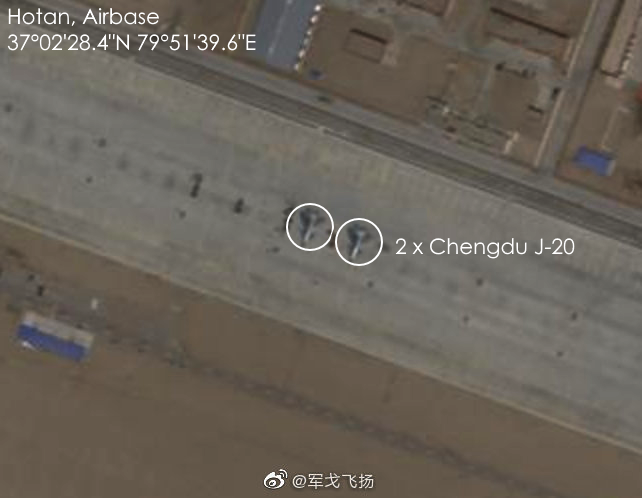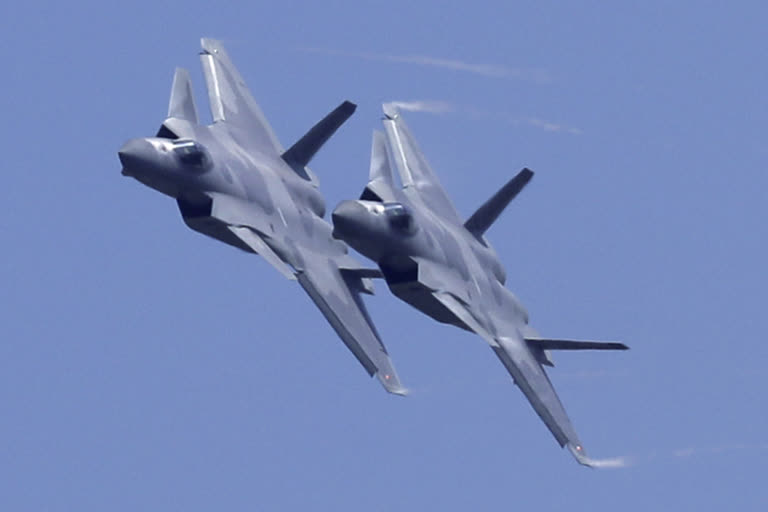New Delhi: China has deployed J-20 stealth fighters in Hotan airbase, escalating its border stand-off with India. The latest satellite images show two PLAAF (People's Liberation Army Air Force) J-20 stealth fighters at an airbase in China's far west.
About 130 km away from the Line of Actual Control (LAC), Hotan is one of the closest PLAAF airbases from the Indian border in the north. Operationalised under the PLA’s western theatre command (WTC), J-10 and J-11 fighters are already based in Hotan. New deployments have included J-8 and J-16s.
The deployment is significant as there is very less doubt that PLA would focus more on the air force, missile and drone assets or on ground forces in case of an open outbreak of hostility with India.

Retaliating the move, India has also deployed a formidable air fleet comprising Sukhoi-30 and Mig 29K fighters, C-17 airlifters, P8 reconnaissance aircraft, Chinook and Apache attack helicopters, a range of other aircraft and UAVs in the Leh airport for undertaking operations along the LAC.
At the moment, the PLAAF is believed to have about 30 Chengdu J-20 air fighters in its fleet. The J-20 fighter aircraft is only the third stealth fighter to enter service with any air force, after the F-22A Raptor and the F-35 Joint Strike Fighter both of which are with the US military.
More than 100,000 soldiers and a vast array of equipment including heavy guns have been mobilised by the two sides along with the frontline and depth areas near the LAC in a nearly four-month-long faceoff that has the deadly potential to be the flashpoint for an all-out conflict.
Built by the Chengdu Aircraft Design Institute and operationalised in the PLAAF in September 2017, China is believed to have very recently begun the mass production of the fifth-generation J-20 fighters which is expected to be the backbone of the PLAAF for the next 20 years.
Besides the stealth element, fifth-generation fighters are faster, more manoeuvrable and have better avionics than the older generations.
While the new J-20 (called the J-20B) will continue to be powered by the Russian Saturn AL-31 engines, it is likely to be replaced by the indigenous Chinese WS-10 Taihang aero-engines in a year or two.
READ: China says ready to address differences with India
At the moment, the PLAAF is believed to have about 30 Chengdu J-20 air fighters in its fleet. The J-20 fighter aircraft is only the third stealth fighter to enter service with any air force, after the F-22A Raptor and the F-35 Joint Strike Fighter both of which are with the US military.
The development follows the deployment of three B2 stealth bombers by the US at its San Diego airbase in the Indian Ocean, ostensibly in a show of strength to warn China.
With US-China belligerence taking an aggressive turn, the Asia-Pacific region has witnessed a flocking of stealth air assets including the deployment of US F-35s and F-22s in Japan and F-35s in South Korea.
Unconfirmed reports speak of the possibility of the B-2 bombers being used for fly-over missions and interoperability exercises near the LAC in an indication of buttressing support to India and other allies in the region.
There is also talk of a Quad firming up on an anti-China platform comprising India, US, Japan and Australia.



